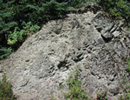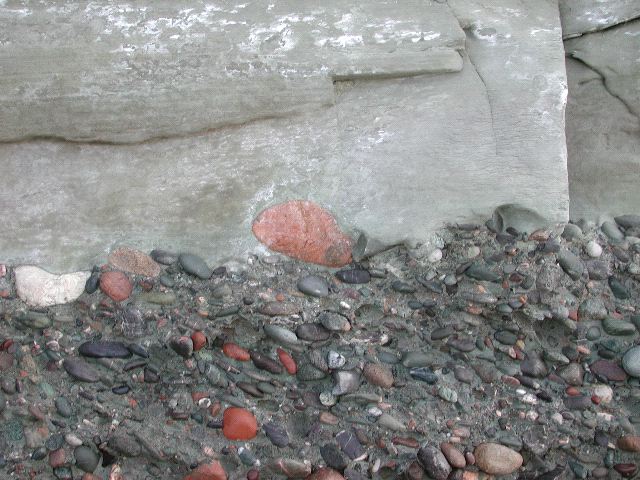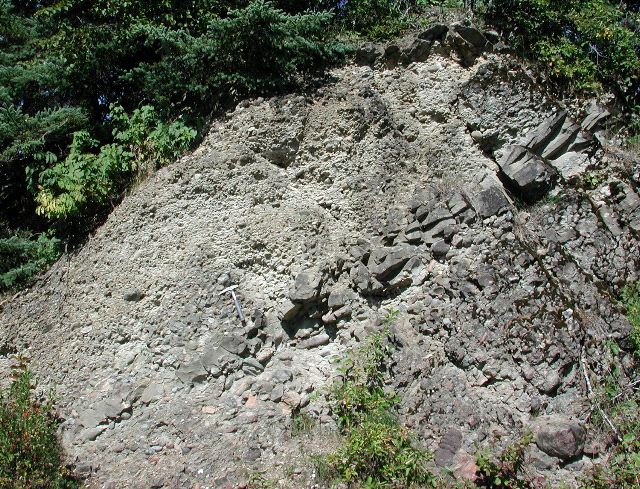The Fleurant Formation

 (76 kb) The formation also includes some thin, discontinuous beds of fine- to coarse-grained sandstone. The approximately 20-metre thick formation is named for Fleurant Arsenault who lent his name Pointe-à-Fleurant, a small promontory in the Ristigouche River estuary.
(76 kb) The formation also includes some thin, discontinuous beds of fine- to coarse-grained sandstone. The approximately 20-metre thick formation is named for Fleurant Arsenault who lent his name Pointe-à-Fleurant, a small promontory in the Ristigouche River estuary.
 (144 kb)The pebbles of the Fleurant Formation reveal that at one time, the hinterland north of Miguasha rose up rapidly, exposing sedimentary and volcanic rocks to erosion. The pebbles made of eroded sedimentary rock, mostly limestone and sandstone, often contain marine fossils (corals, brachiopods and molluscs) with ages ranging from Ordovician to Lower Devonian.
(144 kb)The pebbles of the Fleurant Formation reveal that at one time, the hinterland north of Miguasha rose up rapidly, exposing sedimentary and volcanic rocks to erosion. The pebbles made of eroded sedimentary rock, mostly limestone and sandstone, often contain marine fossils (corals, brachiopods and molluscs) with ages ranging from Ordovician to Lower Devonian.Because the fossils in the Fleurant Formation were not contemporaneous with the encasing sediments, and attempts to date the rocks using spores from the sandy layers have been inconclusive, the age of the rock formation cannot be precisely determined. It can, however, be estimated by deducing its stratigraphic relationship to rock sequences above and below it.

 (80 kb)The Fleurant Formation lies atop another sedimentary sequence, the Pirate Cove Formation, the upper layers of which are Middle Devonian. The basal layers of the Escuminac Formation overlying the Fleurant Formation are of Frasnian age, which represents the earliest part of the Upper Devonian. The age of the Fleurant Formation is thus constrained between the end of the Middle Devonian and the beginning of the Upper Devonian.
(80 kb)The Fleurant Formation lies atop another sedimentary sequence, the Pirate Cove Formation, the upper layers of which are Middle Devonian. The basal layers of the Escuminac Formation overlying the Fleurant Formation are of Frasnian age, which represents the earliest part of the Upper Devonian. The age of the Fleurant Formation is thus constrained between the end of the Middle Devonian and the beginning of the Upper Devonian.The Fleurant Formation conglomerate began as sediment deposited on an alluvial plain fed by rivers with outflows that varied with rainfall and the seasons. The size of the transported rock fragments, which sometimes reach a metre wide, demonstrate how powerful the river currents could be, and that the source regions for the sediments were very close.
The upper contact between the Fleurant Formation and the overlying Escuminac Formation is abrupt. The conglomerates change suddenly into the lower Escuminac sandstone beds, which mould themselves to the irregular upper surface of the conglomerate bed without displacing its pebbles. This type of contact suggests that sediments of the Fleurant alluvial plain had already begun to consolidate before the first layers of Escuminac sediments were laid down, which in turn implies that there was a brief pause in sediment deposition between the two formations.
Site map | Feedback | Links | Sources | Credits
The Fleurant Formation
<< The Miguasha Group | The Escuminac Formation >>

Title: The Fleurant Formation and its contact with the Escuminac Formation
Author: Parc national de Miguasha
Sources: Parc national de Miguasha
Year: 2002
Description:
This photo shows the contact between the conglomerate of the Fleurant Formation (bottom) and the lowermost sandstone beds of the overlying Escuminac Formation. The rounded pebbles and cobbles were derived from the erosion of Ordovician and Siluro-Devonian sedimentary beds that were exposed north of the Miguasha area at that time. The Fleurant and Escuminac sedimentary formations constitute the geological Miguasha Group.

Title: The newly discovered outcrop exposure of the Fleurant Formation at the Municipality of Nouvelle
Author: Parc national de Miguasha
Sources: Parc national de Miguasha
Year: 2005
Description:
The Fleurant Formation cropping out at the eastern edge of the Municipality of Nouvelle. The lower part of the Escuminac Formation and its contact with the Fleurant Formation are also visible at this location.



